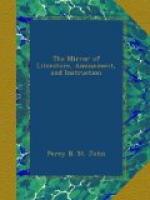[Greek: En nephei staerixe teras meropon anthropon.][5]
“Jove’s wondrous bow of three
celestial dies,
Plac’d, as a sign to man, amidst
the skies.”
The Fall of Manna.
This remarkable and providential supply is thus described: “When the dew that lay was gone up, behold upon the face of the wilderness there lay a small round thing, as small as the hoar-frost, on the ground.” We are further told, that “when the sun waxed hot it melted;” and when preserved until the following day it became corrupt, and “bred worms.” To preserve the extra measure which they collected on the sixth day, Moses directed that on that day of the week they were “to bake and seethe” what should be required on the morrow, as on the sabbath none should fall. It is further added,—“And the house of Israel called the name thereof manna: and it was like coriander-seed, white; taste of it was like wafers made with honey.” Such are the curious and interesting particulars supplied by the Sacred Text. It is well known that a substance is used in medicine under this name, chiefly obtained from the Calabrias, and is collected from the leaves of the ornus rotundifolia, (fruxinas ornus, of Linnaeus,) and a somewhat similar substance obtains in the onion; but from its purgative qualities, it is sufficiently obvious that the manna of the Scriptures is altogether different. According to Seetzen, Wortley Montague, Burckhardt, and other travellers, a natural production exudes from the spines of a species of tamarix, in the peninsula of Sinai. It condenses before sunrise, but dissolves in the sun-beam. “Its taste,” it is added, “is agreeable, somewhat aromatic, and as sweet as honey. It may be kept for a year, and is only found after a wet season.” The Arabs collect it and use it with their bread. In the vicinity of Mount Sinai, where it is most plentiful, the quantity collected in the most favourable season does not exceed six hundredweight. The author of the “History of the Jews” has a note to the following effect:




